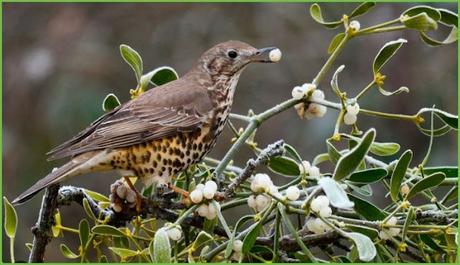When she was a teenager, my youngest daughter used to collect the screw-tops from bottles of Snapple drink because they had interesting facts printed on the underside of the lids. Example: The average person spends two weeks of their lives kissing.
If one were to plot a graph of a population's kissing minutes by days of the year, there would be two statistical peaks: one in mid-February (Valentine's Day) and a much bigger one in late December (around Christmas time). But what's the origin of this seasonal custom and why does mistletoe feature? You'll be delighted to hear that I'm going to kiss-and-tell.
Mistletoe first. It's a parasitic plant growing on a shrub or tree, drawing the water and nutrients it needs from its host via a structure called the haustorium. Viscum album, to give its Latin name, is widespread across the UK and Europe. It has broad green leaves and white berries. There is also a rare, red-berried version, viscum cruciatum, found in southern parts of Portugal and Spain and in Morocco. The derivation of the word is somewhat obscure but is believed to be Proto-Indo-European in origin with Old English addition, from me (with), sed (sit), and tan (twig): a twig that sits with (another). Mistletoe propagates via birds - like the mistle thrush below - who eat the drupes or berries and excrete the seeds they contain onto another tree which soon becomes a new host.

Mistles
All species of mistletoe are toxic to a degree for human beings, though rarely fatal. Blurred vision, diarrhoea and nausea are the commonest reactions to ingestion, though seizures and cardiac arrests have been recorded.The importance of mistletoe in pagan times was essentially religious, its white berries being regarded as a symbol of male fertility. The Ancient Greeks referred to it as "oak sperm", the Celts as "semen of Taranis" (god of thunder), the Romans revered it as a symbol of peace and love and hung it over doorways to protect the household. In Druidic mythology it seems to have served both as fertility symbol and as a medicine (for external use only).
In Christian times across the western world it has become incorporated (like yuletide) as a symbol of regeneration into our Christmas rituals, denoting fecundity and friendship, though the habit of kissing under it appears to be quite recent (late 18th century). It gave license during the festivities around the winter solstice for men to beg kisses of any woman standing under the mistletoe, and bad luck was said to befall a woman who refused. (Unpick the socio-political implications of that one.)
And why the winter solstice rather than the summer one (which also has a wealth of fertility lore associated with it)? Probably simply because mistletoe is more noticeable and much easier to harvest once the leaves have fallen from the (mostly deciduous) host trees. The mistletoe that is sold in our markets and shops in the lead-up to Christmas is harvested in late November and early December. The center of the trade in the UK is at Tenbury Wells in Worcestershire which hosts a mistletoe festival and crowns a mistletoe queen each year.
This latest composition, a love poem of sorts, commemorates a real incident in my past life, on the morning of the winter solstice back in 1975, when I was a student at Exeter University (completing my Postgraduate Certificate of Education). Haldon as mentioned in the poem is Haldon Forest (south of Exeter and just inland from Dawlish), home to red oaks, lots of mistletoe and myriad birds including blackbirds, jays, nightjars and of course mistle thrushes. This may not be its final form as I'll probably tinker with parts until I feel I've done the memory justice.
Mistletoes*Hand in hand in Haldon woods we footed close through frosty ferns,rudely startled blackbirds in our wake. You a copper-haired daughter of Taraniscutely duffled against the snap of winter solstice chill,me more of the long-haired berserker,our twin breaths visibly mingling in still hanging dawn mist
with not a hint of wind beneath those querky oaks with shaggy shocksof parasitic growths, just the thrilling sightof thrushes overhead at first lightmaking breakfast on white berries.
We paused to gaze in wonder, thenyou rose on mistletoes and we kissed(I don't know whether you shut your eyesI certainly closed mine, the nearestI've ever come to a swoon) for minutes until the turning earth stood stillbeneath the rising sun or so it seemed,then spun again.
You named me your Viking lordand I hailed you my Celtic queen,a solemn, sacramental moment at the time, though slightly absurd I supposefor you had a husband waiting at homeand I a train to catch to London at noon,the first of many Christmaseswe never spent together.
* for Hazel, wherever she may be.

Thanks for reading, S ;-) Email ThisBlogThis!Share to TwitterShare to Facebook
